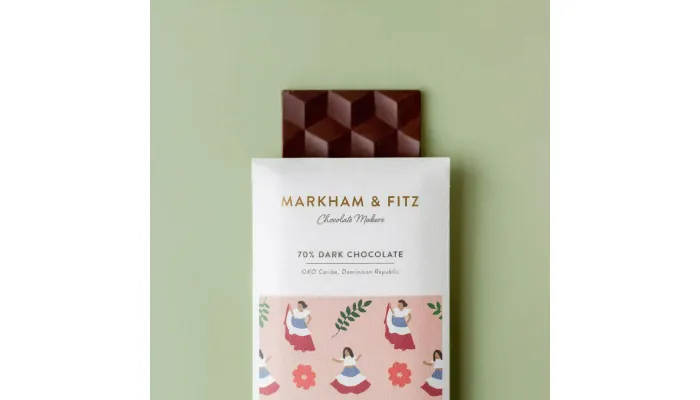
What Makes the Best Dark Chocolate Different?
The best dark chocolate stands out mainly because it contains a high cocoa content, usually above 70%, which brings richer flavors and health benefits due to its antioxidants. Quality starts with cocoa or chocolate liquor as the main ingredient, avoiding unnecessary additives like trans fats or artificial flavors. Processing is also key: avoiding Dutching preserves valuable antioxidants even though roasting and fermentation can reduce some of these compounds. Ethical sourcing adds another layer of value for many consumers. Additionally, some premium chocolates are fortified with natural extracts or probiotics to boost nutrition and taste while maintaining good texture. Altogether, these factors create a chocolate that’s both enjoyable and beneficial.
High Cocoa Content and Ingredient Quality
The best dark chocolate usually contains at least 70% cocoa solids, which gives it a richer, more intense flavor while keeping sugar content low. This higher cocoa percentage not only enhances taste but also boosts the health benefits by reducing added sugars. When checking ingredients, cocoa or chocolate liquor should be the first listed, indicating the chocolate is made mainly from pure cocoa components like cocoa powder, nibs, or cocoa butter. A simple ingredient list without trans fats, artificial flavors, or unnecessary milk solids (except sometimes milk fat for texture) helps preserve the chocolate’s natural taste and nutrition. Some chocolates include lecithin as an emulsifier, often soy-derived, but it isn’t essential for quality. Avoid chocolates processed with alkali (Dutching), since while it darkens the color and softens bitterness, it greatly reduces antioxidants. High-quality dark chocolate often carries certifications like organic or fair trade, signaling ethical sourcing and stricter quality control. The finest cocoa beans come from regions known for unique flavor profiles, such as Ghana, Ecuador, and Madagascar. Proper packaging that protects chocolate from heat and light is also key to maintaining freshness and preserving ingredient integrity.
- Dark chocolate labeled as the best typically contains at least 70% cocoa solids, which contributes to a richer and more intense flavor profile.
- A higher percentage of cocoa means less sugar is present, enhancing the health benefits and reducing sweetness.
- The first ingredient should be cocoa or chocolate liquor, which includes cocoa powder, nibs, or cocoa butter, ensuring authenticity.
- Minimal additional ingredients help preserve the natural taste and nutritional value of the chocolate.
- Avoid chocolates with trans fats, artificial flavors, or milk solids except occasional milk fat used for texture.
- Lecithin, often soy-derived, may be included as an emulsifier but is not necessary for quality products.
- Avoid chocolates processed with alkali (Dutching) as it darkens color but reduces antioxidants and bitterness.
- Look for certifications such as organic and fair trade, indicating ethical sourcing and potentially better quality control.
- High-quality cocoa beans are sourced from regions known for their flavor profiles, such as Ghana, Ecuador, or Madagascar.
- Packaging should protect the chocolate from heat and light to maintain ingredient integrity and freshness.
Natural Ingredients and Minimal Additives
The best dark chocolate stands apart because it relies on a simple, natural ingredient list, focusing on cocoa solids, cocoa butter, and sugar without unnecessary fillers or artificial additives. This purity ensures the chocolate’s true flavor shines through without interference from artificial flavorings or preservatives, which can dull the natural taste. Sugar is kept to a minimum relative to the cocoa content, balancing bitterness without overwhelming it. Typically, milk solids are excluded to maintain the intense dark character, though some blends may contain trace amounts. These chocolates contain no trans fats, which can harm both health and texture, while natural emulsifiers like lecithin may be used sparingly to improve smoothness and viscosity. Flavor enhancers such as vanilla or vanilla extract are favored over synthetic chemicals to keep the chocolate’s profile authentic. By avoiding excessive additives, the natural antioxidants and bioactive compounds in cocoa remain intact, preserving health benefits and flavor complexity. A simple ingredient list on the label is often a reliable sign of quality and purity, reflecting careful sourcing and minimal processing that respects the cocoa’s natural qualities.
How Processing Impacts Dark Chocolate Quality?
The quality of dark chocolate is deeply influenced by each step in its processing, which can either enhance or diminish its flavor and health benefits. Fermentation is a crucial first step, where natural microbes develop the complex flavors chocolate is known for. However, this process also causes a 20 to 40 percent reduction in polyphenols and antioxidants, key compounds responsible for chocolate’s bitterness and health effects. Drying further lowers moisture but can lead to even larger losses of polyphenols, between 44 and 77 percent, and flavan-3-ols, important flavonoids, which may drop by as much as 80 percent. Roasting is essential for developing the chocolate’s aroma and taste through Maillard reactions, yet high temperatures and long roasting times can destroy up to half of the remaining polyphenols. Therefore, controlling time and temperature during roasting is critical to balance flavor and nutrient preservation. Grinding and conching refine the texture, and when done briefly, they cause minimal polyphenol loss, around 3 percent. Tempering then stabilizes cocoa butter crystals, improving the chocolate’s smoothness and shine without affecting its bioactive compounds. Importantly, avoiding Dutching or alkali processing preserves the natural antioxidants and bitterness, since alkali treatment significantly reduces antioxidant content while altering flavor. Manufacturers aiming for the best dark chocolate carefully manage these processes to keep as much of cocoa’s natural qualities intact while producing a pleasant taste and mouthfeel. Over-processing not only dulls flavor but also diminishes the health benefits by degrading flavonoids and antioxidants that make dark chocolate special.
Bioactive Compounds and Nutritional Benefits
Dark chocolate stands out because of its rich content of bioactive compounds, especially polyphenols and flavonoids like catechins, epicatechins, and procyanidins. These antioxidants help neutralize free radicals, reducing oxidative stress that can contribute to heart disease and cancer. It also contains non-flavonoid polyphenols such as stilbenes (including resveratrol) and phenolic acids, which support heart health and reduce inflammation. Methylxanthines, mainly theobromine and caffeine, act as mild stimulants and add to antioxidant effects. Theobromine, in particular, has unique benefits: it raises good (HDL) cholesterol, relaxes bronchial muscles to aid breathing, and even strengthens tooth enamel, giving dark chocolate an edge in oral health. Beyond these compounds, dark chocolate provides essential minerals like magnesium, potassium, iron, zinc, copper, calcium, and phosphorus, all important for cardiovascular and metabolic functions. It also supplies B-complex vitamins (B1, B2, B3, B9) and vitamin K, which play roles in brain health and blood clotting. Polyphenols help improve blood flow by enhancing nitric oxide availability in blood vessels, which can lower blood pressure and support overall heart function. Moreover, these compounds assist insulin sensitivity and glucose metabolism, making dark chocolate potentially helpful in managing diabetes. Altogether, the unique combination of these bioactive compounds and nutrients is what differentiates the best dark chocolate, offering more than just a rich flavor but a variety of health-supporting benefits.
Health Effects of the Best Dark Chocolate
The health effects of the best dark chocolate go far beyond its rich taste. Key bioactive compounds like flavonoids play a central role in improving heart health by enhancing blood vessel function and reducing LDL oxidation, which helps lower the risk of cardiovascular disease. These antioxidants also reduce inflammation by influencing immune responses and cytokine levels, contributing to overall bodily balance. Regular moderate consumption has been shown to improve insulin sensitivity, which can lower the risk of metabolic syndrome and type 2 diabetes. Dark chocolate also supports brain function by increasing cerebral blood flow and promoting nerve growth factors, with some studies indicating potential neuroprotective benefits against conditions such as Alzheimer’s and Parkinson’s diseases. The presence of theobromine and polyphenols further aids in weight management by reducing fat cell formation and boosting metabolism. Additionally, dark chocolate benefits oral health by strengthening tooth enamel and lowering the chance of tooth decay. Its polyphenols act as antioxidants that reduce markers of oxidative stress and inflammation throughout the body. Moderate intake can also improve HDL cholesterol levels while lowering blood pressure and arterial stiffness, reinforcing cardiovascular support. Overall, the best dark chocolate contributes positively to cardiovascular, metabolic, cognitive, and immune health when enjoyed responsibly.
Common Fortification Methods and Their Benefits
Dark chocolate can be enhanced through various fortification methods that boost its nutritional and health-promoting qualities without compromising its natural appeal. Adding fruit extracts like black mulberry or elderberries increases anthocyanin levels, which are powerful antioxidants supporting cardiovascular health. Similarly, spices such as cinnamon, green tea, and turmeric raise polyphenol content while introducing unique flavor notes that complement chocolate’s bitterness. Prebiotics like inulin and probiotics, including Lactobacillus strains, help improve gut health by balancing the microbiota, turning dark chocolate into a functional food for digestive wellness. Polysaccharides such as polydextrose reduce sugar content, add dietary fiber, and improve texture, making chocolate a better choice for those managing sugar intake. Algae-based additives like spirulina and astaxanthin enrich the chocolate with vitamins, notably vitamin A, and antioxidants that further protect cells from oxidative stress. Incorporating lipid components such as phytosterols and omega-3 fatty acids (DHA/EPA) enhances heart health benefits, supporting cholesterol regulation and reducing inflammation. Whey protein isolate combined with erythritol increases protein content and extends shelf life without adding sugar, appealing to consumers looking for sustained energy and longer-lasting products. Enriching dark chocolate with flavonols and anthocyanins builds on its natural antioxidant profile, amplifying cardiovascular and metabolic advantages. Fortification can also target specific health outcomes like metabolic support or cognitive enhancement, making dark chocolate a versatile carrier for functional ingredients. Importantly, these natural fortifiers maintain or improve sensory qualities, ensuring that the health benefits come without sacrificing the rich taste and smooth texture that define the best dark chocolate.
How Fortification Changes Chocolate Properties?
Fortifying dark chocolate can noticeably change its physical and sensory characteristics, which requires careful formulation to maintain quality. Additions like fibers, prebiotics, or plant extracts often alter viscosity and texture, sometimes making the chocolate thicker or affecting how it melts. Color and flavor profiles may shift as well, but balancing these ingredients helps preserve the familiar rich taste and appearance consumers expect. Nutritionally, fortification boosts total polyphenol and flavonoid levels, enhancing antioxidant activity measured by assays such as DPPH and FRAP. Adding vitamins, minerals, proteins, and fiber not only replenishes nutrients lost during processing but also supports health benefits like improved cardiovascular function and metabolic regulation. For example, sugar and calorie content often decrease when fiber or prebiotics replace part of the sugar, making fortified chocolates more suitable for diabetics or those managing weight. Some formulations also include probiotics that stay viable through shelf life, promoting gut health. These changes expand chocolate’s therapeutic profile to include anti-inflammatory and neuroprotective effects. Importantly, consumer acceptance remains high when fortification does not compromise taste or texture, showing that with precise balancing, fortified dark chocolate can deliver enhanced nutrition and health benefits without losing its classic appeal.
Consumer Preferences and Taste Balance
Dark chocolate lovers often look for a harmony between bitterness and sweetness, with the ideal cocoa content usually falling between 70% and 85%. This range offers a rich, intense flavor without overwhelming bitterness. Adding fruits and spices can enhance the complexity of flavors, making the chocolate more appealing by softening harsh notes and introducing subtle aromatic layers. Bitterness and astringency from natural polyphenols are often balanced by natural sweeteners or flavor enhancers that keep the experience enjoyable rather than off-putting. Texture plays a big role, too, consumers favor smooth, creamy chocolates that melt easily rather than those with dry or gritty mouthfeel. Health-conscious buyers want chocolates that not only taste good but also offer functional benefits, such as probiotics or prebiotics that support gut health. Fortified dark chocolates attract a wide audience, including athletes and diabetics, who appreciate functional foods that don’t sacrifice flavor. Packaging and branding emphasizing natural ingredients and ethical sourcing also influence buying decisions, as many consumers seek products that combine indulgence with health and responsibility. Taste tests confirm that chocolates with modest fortification and well-balanced flavors maintain or even boost consumer acceptance, showing that health benefits and enjoyment can go hand in hand.
Future Trends in Dark Chocolate Development
Research in dark chocolate development is increasingly focusing on cost-effective ways to enhance its health benefits while maintaining taste and bioactive compound stability. One promising direction is using by-products from fruit and vegetable processing as natural fortifiers, which not only boosts antioxidant content but also supports sustainability by reducing food waste. Personalized nutrition is shaping the future too, with chocolates potentially tailored to meet the needs of specific groups such as athletes seeking performance support, diabetics requiring low-sugar options, or individuals focused on cognitive health. Advances in probiotic delivery within chocolate aim to improve gut health, making dark chocolate a vehicle for beneficial bacteria without sacrificing flavor. Novel plant extracts and herbal additions continue to be explored for their antioxidant and anti-inflammatory effects, with the goal of creating functional chocolates that support overall wellness. Processing improvements are critical as well, particularly methods that better preserve polyphenols while enhancing flavor profiles. Additionally, the trend towards low-sugar, high-fiber dark chocolates aligns with growing consumer demand for healthier indulgences. Packaging innovations are also underway to extend shelf life and protect sensitive bioactive compounds. The integration of functional lipids and proteins to support heart and metabolic health is expected to increase, positioning fortified dark chocolate as a functional food that balances indulgence with tangible health benefits, capturing growing market interest globally.
Resource URL:



